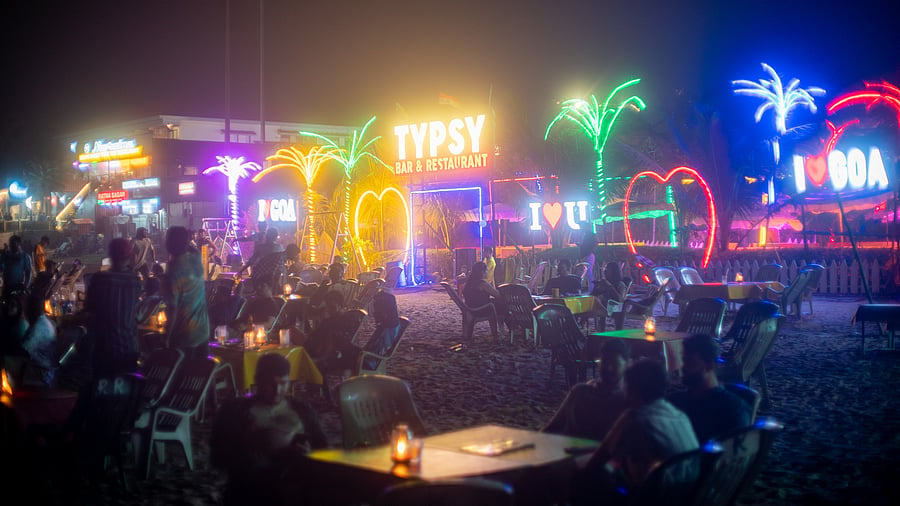
Tourists at a beachside shack in Goa
Credit: iStock Photo
Recently, my school alumni group was pondering a destination for a group holiday. It was then that many of us confessed to having not seen much of our own vast country.
The range and scope of domestic attractions is mind-boggling. From the snowy slopes of Gulmarg to the ancient monuments of Hampi to the scenic locales of Coorg, there is a seemingly endless array of places to visit.
If that’s the case, why do so few international tourists flock to these destinations? Less than 10 million tourists arrive here annually compared to 10 times that level in European countries like France. On the other hand, domestic tourism is thriving in the post-Covid-19 era, with religious sites topping the list. The Maha Kumbh Mela, for instance, is expected to push growth in the fourth quarter of FY2025 to 7.6 per cent according to Chief Economic Adviser Anantha Nageswaran.
The resurgence of religious tourism has been exponential after the ‘Pran Pratishtha’ of the Ram temple in Ayodhya. Official data released shows that the number of visitors to the district has risen from about six million in 2020 to over 16 million in 2024. Reports also show that more tourists visited the Ram temple than the iconic Taj Mahal in the first nine months of 2024. The Ayodhya phenomena has been followed up with the rush of 55-60 crore pilgrims to the Maha Kumbh Mela. Uttar Pradesh is at the centre of the spiritual tourism boom as Varanasi has also become part of the religious circuit.
The uptick in domestic tourism, and the impact of the ‘huge spending’ at religious sites are now recognised by policymakers as having the potential to raise overall growth. Such a realisation seems to have been the driver for the focus on tourism in the 2025-26 Budget proposals. These included a plan to transform 50 destinations into ‘world-class’ tourism hubs along with a steep hike in the financial allocation for the sector. It was raised by nearly three times from the revised estimates of Rs 850.36 crore in 2024-2025 to Rs 2,479 crore in 2025-2026. In addition, schemes to develop Buddhist circuits and medical tourism facilities have been outlined in the proposals.
The stress given to tourism development is welcome, but overdue given the industry’s collapse during the pandemic. The fact that the sector has rebounded strongly has more to do with the strong revival in demand for tourism services in the post-Covid-19 era rather than any governmental support.
The significance of the industry is evident from official data showing that it comprises 5 per cent of GDP currently. But these statistics also highlight that its share in GDP had fallen to 1.5 per cent and 1.75 per cent in 2020-2021 and 2021-2022 respectively from 5.18 per cent in 2019-2020. In other words, Covid took a heavy toll on the tourism and hospitality industry.
It is, thus, heartening that more schemes are being evolved to develop infrastructure for a sector that has the potential to emerge as a massive revenue earner for the economy. Yet new schemes are not enough as there is a need to upgrade existing facilities for foreign tourists who are bypassing India for other destinations. The reasons for viewing India as a difficult holiday locale need to be examined and remedied without delay.
It is interesting that even the international media, including The Economist, have commented on India’s failure to capitalise on its strengths as a tourist destination despite having 46 UNESCO World Heritage sites and tremendous natural beauty. It noted that even tiny Dubai easily mops up 14,7 million visitors annually while this continent-size country has only touched a peak of 11 million tourists. The reasons cited are bureaucratic issues related to visas, outmoded websites, traffic, and pollution.
In other words, it is time for Nageswaran to repeat the mantra of ‘get out of the way’ to the bureaucracy dealing with tourism. As for government websites, it is surprising that a country renowned globally for information technology skills is reliant on outdated tech interfaces for many of its government websites.
On a more basic issue, sanitation and hygiene facilities are still below the mark at leading tourist sites, including those operated by the Archaeological Survey of India (ASI). More resources also need to be poured into ensuring proper maintenance of India’s innumerable heritage sites. With better infrastructure, these can easily become magnets for visitors.
Till the time such upgrades take place, however, the country has no option but to rely on domestic tourism to become a driver of higher economic growth.
(Sushma Ramachandran is a senior journalist.)
Disclaimer: The views expressed above are the author's own. They do not necessarily reflect the views of DH.